
Portion of a larger Paul Conrad cartoon from the 1970s showing President Richard Nixon caught up in a Watergate spider web.
In the 1970s, Conrad was among cartoonists who chronicled Nixon’s troubles during his presidential demise via the Watergate scandal.
Watergate was the office complex in Washington, DC where the attempted electronic bugging of Democratic Party headquarters by a Nixon White House-led team of burglars, would lead to a White House slush fund, an attempted cover up, and ultimately Nixon’s resignation from office.
Conrad’s spider web cartoon at right, for example, reveals a Nixonian web of Watergate co-conspirators, their names cleverly spelled out in the web’s structure — “Ehrlichman”, “Haldeman”, “Magruder”, “Dean”, and others. These were the men involved with Nixon in the Watergate scandal who, by their actions and participation, helped incriminate and ensnare President Nixon in the end.
Paul Conrad was also probably the first cartoonist to associate the Watergate break-in with Nixon, publishing the cartoon below on June 18, 1972, the day after the Watergate break-in was reported as a minor burglary. At the time, only a handful of people even suspected there might be a White House connection. Conrad by then was an established national political cartoonist and known as an “equal opportunity offender,” lampooning all manner of politicians and public figures regardless of affiliation.
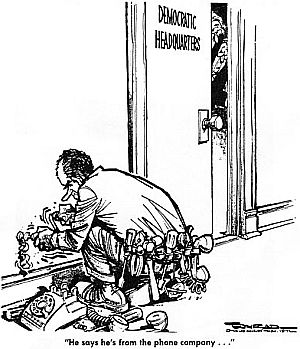
In this June 1972 Paul Conrad cartoon, Democrats are peeking out their doorway, looking at a Nixon-caricatured repair man, saying: “He says he’s from the phone company...”
“Throughout our history…,” Conrad explained to the Des Moines Register’s Tom Longden in 2009, “it’s always come down to the friction between the haves and have-nots, or between the average Joes and the large corporations. So that’s a recurring theme in my work.”
In his career, Conrad skewered 11 presidents – Truman, Eisenhower, Kennedy, Johnson, Nixon, Ford, Carter, Reagan, Clinton and the two Bushes. He also won three Pulitzer Prizes for this work of poking fun at politicians during a 50-year career. He spent 30 years at the Los Angeles Times, where his lampooning helped raise the newspaper’s national profile.

Paul Conrad working on a drawing at his desk, 1970s.
Nixon’s Enemies List

Paul Conrad’s caricature of President Richard Nixon sitting amid pages and pages of his infamous “enemies list.” Caption reads: “His own worst enemy.” Date: 1973.
The existence of such a list first became public when former White House lawyer and Nixon ally, John Dean, mentioned them during the Senate Watergate hearings. In his testimony, Dean then noted that a list existed containing names of those the president did not like.
On June 27, 1973, the Senate Watergate Committee released the first White House Enemies List in two parts, a top 20 list for special attention and another list of about 200 “Political Opponents.” Together, these names comprise what is also known as “Nixon’s First Enemies List.”
The official purpose of the list, as described by the White House Counsel’s Office in one 1971 memo, was to “screw” Nixon’s political enemies by means of IRS tax audits and/or other means, such as manipulating grant availability and federal contracts, or through litigation and prosecution. In an August 1971 memorandum from John Dean to Lawrence Higby, Dean explained the purpose of the list:
“This memorandum addresses the matter of how we can maximize the fact of our incumbency in dealing with persons known to be active in their opposition to our Administration; stated a bit more bluntly—how we can use the available federal machinery to screw our political enemies….”
Later, a much longer list consisting of some 576 names was also revealed – a list which included hundreds of names that had been sent by Nixon’s people to the IRS in 1972 for possible tax audits. That’s the list on which Paul Conrad’s name appeared. Conrad, however, was in good company, as the full list included many political notables, selected publications, and celebrities, among them: Bill Cosby, Gregory Peck, Ted Kennedy, Shirley Chisholm, Joe Namath, Jane Fonda, Bella Abzug, Barbra Streisand, Carol Channing, The New York Times, The Washington Post, and many others.

A Paul Conrad 1970s cartoon depicting President Nixon as a criminal barricaded in the White House with caption, “If you want me, you’re gonna have to come in and get me!” – reminiscent of some Hollywood movie scenes.
As Nixon faced an almost certain impeachment in House of Representative and likely conviction in the Senate, Conrad did an Easter Sunday cartoon of Richard Nixon nailing himself to a large cross that the Los Angeles Times refused to run, believing it too offensive.
After the White House tape recording system came into play, helping incriminate Nixon, Conrad drew Nixon in a cartoon pinned down by audiotapes, after a scene from Jonathan Swift’s Gulliver’s Travels, with Gulliver (Nixon) among the Lilliputians.
Near Nixon’s end in the White House, Conrad had Nixon in very dark cartoon with crown on his head quoting Shakespeare’s King Richard II: “O that I were as great as my grief, or lesser than my name. Or that I could forget what I have been. Or not remember what I must be now.” Later, at Nixon’s resignation and his famous departure by helicopter, Conrad drew Nixon’s helicopter flying over the White House with the caption: “One flew over the cuckoo’s nest.” Some years later, in 1977-78, Conrad savored some irony when he was chosen that year to hold the Richard M. Nixon lecture chair at Whittier College, the president’s alma mater.
Conrad would also skewer President Gerald Ford in September 1974 for pardoning Richard Nixon. That cartoon has Gerald Ford looking out at the reader, holding an official looking, scroll-type piece of paper with seal, etc. that is titled “Pardon” and reads: “I herewith pardon Gerald R. Ford for the presidential pardon granted to former president Richard M. Nixon by President Gerald R. Ford. – (signed), Gerald R. Ford.” Said Ford of Conrad: “Laugh and the world laughs with you. Cry and you’ve been the subject of a Paul Conrad cartoon.”
Democrats, Too
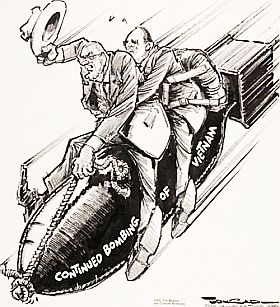
Paul Conrad, “We're Gonna' Make History, Hubert!!,” Los Angeles Times, 1968, Re: Continued Bombing of Vietnam. Syracuse University Library’s Special Collections Research Center.
Conrad’s cartoons weren’t all critical, and could also be praiseworthy, as one he did in 1958 lauding Eisenhower’s enforcement of the Supreme Court’s school desegregation order. Ike had sent army troops to enforce the law and help integrate Little Rock Central High School in Arkansas. Conrad also went after the Democrats.
In the 1960s, he lampooned Democratic President Lyndon B. Johnson and became quite critical of Johnson. Conrad believed Johnson’s policies during the Vietnam War were despicable, drawing one 1964 cartoon showing Congress supplying the president with a “blank check” to wage war on Vietnam.
“I really detested Lyndon Johnson,” Conrad said. “For the Vietnam thing, that’s the one you could really get your teeth into. That was wrong, man, from the word go.”
Another of Conrad’s LBJ cartoons from 1968, shown above right, came at the time Johnson was bombing North Vietnam. The cartoon has Johnson with his vice-president, Hubert Humphrey, riding a bomb similar to a scene from the Dr. Stranglove film in which actor Slim Pickens rides a bomb in similar fashion. The caption reads: “We’re gonna’ make history, Hubert!”
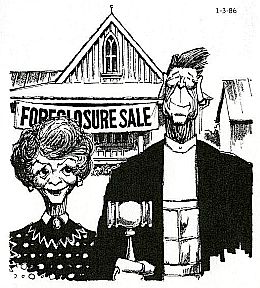
Paul Conrad’s Nancy & Ronald Reagan in send up of “American Gothic” during 1980s farm crisis.
He once had the president shown as “Reagan Hood,” stealing from the poor to give to the rich. Another, shown at left, had Ronald and Nancy Reagan in a send up of Grant Wood’s classic American Gothic pose, made during the 1980s farm crisis when thousands of farm families were losing their farms to foreclosures, and as some charged, to Reagan policies. Conrad also skewered Reagan’s foreign policies; one cartoon had the president in a bathtub playing with warships and a rubber duck. In 1993, Conrad accepted a buyout from the Los Angeles Times, but he continued to draw syndicated cartoons for more than 15 years.
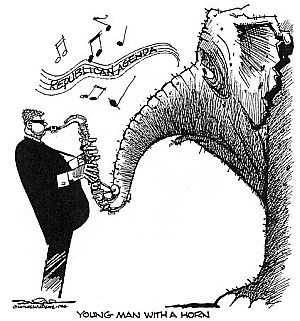
In 1994, Paul Conrad cast Bill Clinton as playing the Republican's song.
In the early 1990s, Conrad came after President Bill Clinton with a few hits as well. “Clinton was a disappointment,” Conrad would later say. “I mean, he became more of a Republican than most Republicans. He sold out the Democratic party, as far as I can tell.” One 1994 cartoon by Conrad, shown at right, has Clinton kow-towing to the Republican agenda, playing his saxophone into the Republican elephant’s trunk, with the caption, “Young man with a horn.”
In his career, Paul Conrad also did some sculpture, and he designed limited-edition bronze figures depicting Ronald Reagan, Richard Nixon, John F. Kennedy, Robert F. Kennedy, Golda Meir and Martin Luther King Jr. One of his sculptures, entitled “Chain Reaction,” made of chains depicting the dangers of a nuclear war, was placed in front of the Santa Monica Civic Center in California. His cartoons have also been published in a number of books, including: When in the Course of Human Events (1973, with Malcolm Boyd), The King and Us (1974), Pro and Conrad (1979), Drawn and Quartered (1985), Conartist (1993), Drawing the Line (1999), and I, Con (2006).

Paul Conrad's Sarah Palin, post-election 2008, slaying the Republican elephant.
Other stories at this website on Richard Nixon include: “Nixon’s Checker’s Speech, 1952,” “1968 Presidential Race – Republicans,” and “The Frost-Nixon Biz, 1977-2009.” See also the “Politics & Culture” page for stories in that category, or visit the Home Page for further choices. Thanks for visiting — and if you like what your find here, please make a donation to help support the research and writing at this website. Thank you. – Jack Doyle
|
Please Support Thank You |
____________________________________
Date Posted: 19 May 2011
Last Update: 1 April 2019
Comments to: jdoyle@pophistorydig.com
Article Citation:
Jack Doyle, “Enemy of the President, 1970s,”
PopHistoryDig.com, May 19, 2011.
____________________________________
Sources, Links & Additional Information
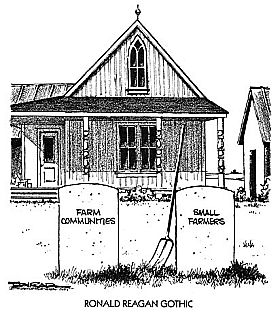 Another Paul Conrad “American Gothic” send up, this one charging Ronald Reagan’s policies with driving small farmers out of business & killing their communities. |
Matt Schudel, “Paul Conrad, 86: Pulitzer-Winning Political Cartoonist,” Washington Post, September 6, 2010, p. B-4.
James Rainey, “Cartoonist Had A Sharp Pen: His Drawings Bedeviled Nixon, Reagan and Others in Power. He Worked at the Los Angeles Times for Nearly 30 Years” (front-page obituary, at his death), Los Angeles Times, September 5, 2010.
Tom Longden, “Paul Conrad’s Cartoons Carry Strong Messages,” Des Moines Register, March 25, 2009.
“Master List of Nixon’s Political Opponents,” Wikipedia.org.
William Claiborne, “IRS Ignored Bid to Audit ‘Enemies’ List,” Washington Post, December 21, 1973, p.1.
“The Complete, Annotated Nixon’s Enemies List,” EnemiesList.info.
Yvonne French, “Afflicting the Comfortable: Cartoonist Paul Conrad Puts Words Behind the Pictures,” Library of Congress.
Paul Conrad, Drawing the Line: The Collected Works of America’s Premier Political Cartoonist, Los Angles: Los Angeles Times, 1999 (this collection of 200 Conrad pieces spans his career from the 1960s to the 1990s).
Paul Conrad, Conartist: Paul Conrad: 30 Years With the Los Angeles Times, Los Angeles: Los Angeles Times, 1993 (a three-decade retrospective of Conrad’s work at the Los Angeles Times).
Paul Conrad: Drawing Fire, Independent Lens/PBS Documentary, PBS.org, Independent Television Service (ITVS), October 2006.
James Preston Allen, Publisher, “Censored in LA: Paul Conrad Speaks on Why His Cartoons Won’t Be Seen by Angelenos,” Random LengthNews.com, July 8, 2005
Michael Dooley, “Conrad, Mauldin and Nast: A Personal Perspective on Editorial Cartoons, Past and Present,” Aiga.org, September 21, 2010
“I Con, The Brilliant Work of Paul Conrad,” Exhibition Photographs, College of the Canyons, Santa Clarita, CA, September 1 – September 30, 2010.
_____________________________
